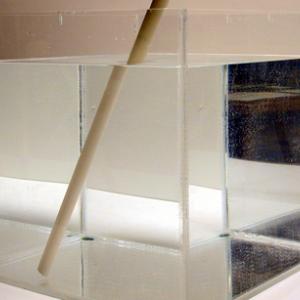College of Liberal Arts & Sciences
6A42.45 - Refraction - Broken Rod
Place the rod in the water filled beaker at a slight angle and observe the rod appears to be broken at the air/water interface. When doing this in the square tank the effect is most visible when looking into the side from an angle and not directly at 90 degrees.
- Walter Trikosko, "Shooting Fish in a Barrel: A Demonstration of the Refraction of Light", TPT, Vol. 52, # 6, Sept. 2014, p. 367.
- Bruce Illingworth, "Photo of the Month", TPT, Vol. 50, # 8, Nov. 2012, p. 501.
- Hubert Biezeveld, Nienke Elsinga, Floor- Jolijn Harmsen, and Rose Koopman, "Analysis of Pictures Taken with an Underwater Camera", TPT, Vol. 43, # 3, Mar. 2005, p. 158 - 161.
- Denise M. Welt, "Bear to the Left", TPT, Vol. 34, # 7, Oct. 1996, p. 456.
- Haym Kruglak, "Erratum", TPT, Vol. 26, # 6, Sept. 1988.
- Haym Kruglak, "Swimming Pool Optics", TPT, Vol. 25, # 7, Oct. 1987, p. 440.
- R. C. Nicklon, W. C. Connolly, "Rugged Refraction Demonstration", AJP, Vol. 43, # 1, Jan. 1975, p. 112.
- Od-5: Freier and Anderson, A Demonstration Handbook for Physics.
- O-210: "Bent Ruler and Spoon in Glass", DICK and RAE Physics Demo Notebook.
- Robert Ehrlich, "10.2, Finding n Using a Pencil in a Glass of Water", Why Toast Lands Jelly-Side Down, p. 157.
- Pat Murphy, Ellen Macaulay, and the staff of the Exploratorium, "Hey, Who Broke My Straw?"Exploratopia, p. 288.
- Janice VanCleave, "36, Broken Pencil", Teaching the Fun of Physics, p. 58.
- H.J. Press, "Broken Pencil", Giant Book of Science Experiments, p. 208.
- T. D. Rossing, C. J. Chiaverina, "# 1, Bent Pencil", Light Science, Physics and Visual Arts, p. 101.
- Julius Sumner Miller, Q20 & A20, Millergrams I – Some Enchanting Questions for Enquiring Minds, p. 24 & 83.
Disclaimer: These demonstrations are provided only for illustrative use by persons affiliated with The University of Iowa and only under the direction of a trained instructor or physicist. The University of Iowa is not responsible for demonstrations performed by those using their own equipment or who choose to use this reference material for their own purpose. The demonstrations included here are within the public domain and can be found in materials contained in libraries, bookstores, and through electronic sources. Performing all or any portion of any of these demonstrations, with or without revisions not depicted here entails inherent risks. These risks include, without limitation, bodily injury (and possibly death), including risks to health that may be temporary or permanent and that may exacerbate a pre-existing medical condition; and property loss or damage. Anyone performing any part of these demonstrations, even with revisions, knowingly and voluntarily assumes all risks associated with them.
